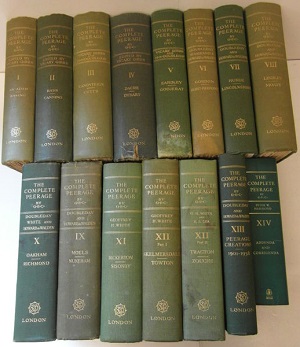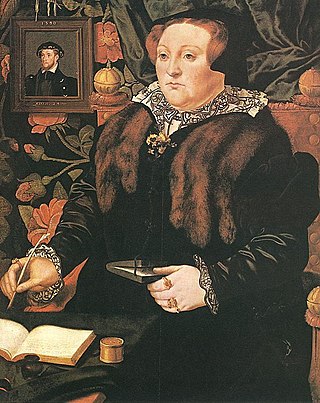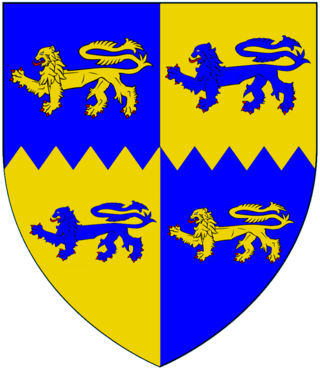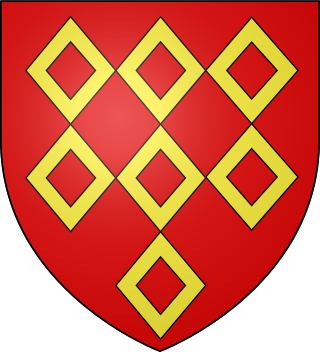Related Research Articles
Robert Ferrers of Wem. He was born in Willisham, Suffolk.
Richard de Clare, 3rd Earl of Hertford, feudal baron of Clare in Suffolk, and lord of Tonbridge in Kent and of Cardigan in Wales, was a powerful Anglo-Norman nobleman with vast landholdings in England and Wales.

William III de Ferrers, 5th Earl of Derby of Chartley Castle in Staffordshire, was an English nobleman and major landowner, unable through illness to take much part in national affairs. From his two marriages, he left numerous children who married into noble and royal families of England, France, Scotland and Wales.

The House of Burgh or Burke was an ancient Anglo-Norman and later Hiberno-Norman aristocratic dynasty which held the earldoms of Kent, Ulster, Clanricarde, and Mayo at various times, provided queens consort of Scotland and Thomond and kings of Britain, and played a prominent role in the Norman invasion of Ireland.
Gilbert Fitz Richard, 2nd feudal baron of Clare in Suffolk, and styled "de Tonbridge", was a powerful Anglo-Norman baron who was granted the Lordship of Cardigan, in Wales c. 1107–1111.
Richard fitz Gilbert de Clare 3rd feudal baron of Clare in Suffolk, was an Anglo-Norman nobleman. A marcher lord in Wales, he was also the founder of Tonbridge Priory in Kent.

Thomas Howard, 8th Duke of Norfolk, Earl Marshal was an English peer and politician. He was the first son of Lord Thomas Howard and Mary Elizabeth Savile. Upon the death of his uncle Henry Howard, 7th Duke of Norfolk, he inherited the titles of 17th Baron Furnivall and 8th Duke of Norfolk. He married Maria Shireburn, daughter of Sir Nicholas Shireburn, 1st and last Bt., of Stonyhurst Hall, on 26 May 1709, when she was age 16 and a half, with a fortune of more than £30,000.

The Complete Peerage ; first edition by George Edward Cokayne, Clarenceux King of Arms; 2nd edition revised by Vicary Gibbs et al.) is a comprehensive work on the titled aristocracy of the British Isles.

William Knollys, 1st Earl of Banbury, KG, PC was an English nobleman at the court of Queen Elizabeth I and King James I.

Mary Fiennes, Baroness Dacre was the daughter of George Neville, 5th Baron Bergavenny by his third wife, Lady Mary Stafford, youngest daughter of Edward Stafford, 3rd Duke of Buckingham.

John Paulet, 2nd Marquess of Winchester, styled The Honourable John Paulet between 1539 and 1550, Lord St John between 1550 and 1551 and Earl of Wiltshire between 1551 and 1555, was an English peer. He was the eldest son of William Paulet, 1st Marquess of Winchester and Elizabeth Capel.
The Dunbar, later Hope-Dunbar Baronetcy, of Baldoon, is a title in the Baronetage of Nova Scotia. It was created on 13 October 1664 for David Dunbar, with remainder to his heirs male and tailzie. The baronetcy became dormant on his death in 1686. The title remained dormant until 1916, when it was successfully claimed by Charles Hope-Dunbar, who became the sixth Baronet. He was a descendant of Mary, granddaughter and sole heiress of the first Baronet. Hope-Dunbar was also the grandson of the Hon. Charles Hope, third son of John Hope, 4th Earl of Hopetoun. Consequently, the present holder of the baronetcy is also in remainder to the earldom of Hopetoun and its subsidiary titles the viscountcy of Aithrie, lordship of Hope and baronetcy of Kirkliston, titles held by his kinsman the Marquess of Linlithgow.

Henry Cromwell, 2nd Baron Cromwell, the son of Gregory Cromwell, 1st Baron Cromwell and Elizabeth Seymour, was an English peer during the reign of Elizabeth I. He was the grandson of Henry VIII's chief minister, Thomas Cromwell, 1st earl of Essex, nephew of the Protector Somerset and first cousin of Edward VI.

Thomas Burgh, 3rd Baron Burgh KG 3rd Baron Borough of Gainsborough, de jure7th Baron Strabolgi and 9th Baron Cobham of Sterborough was the son of William Burgh, 2nd Baron Burgh and Lady Katherine Clinton, daughter of Edward Clinton, 1st Earl of Lincoln and Elizabeth Blount, former mistress of King Henry VIII. He was one of the peers who conducted the trial of the Duke of Norfolk in 1572.

Thomas Cromwell, 1st Earl of Ardglass, 11 June 1594 to 20 November 1653, was an English nobleman, son of Edward Cromwell, 3rd Baron Cromwell and his second wife Frances Rugge.

Sir William Brandon, of Wangford in Suffolk, was an English landowner, administrator, soldier, courtier and politician. His grandson was Charles Brandon, 1st Duke of Suffolk, a courtier and close friend of King Henry VIII.
Robert fitzRoger was an Anglo-Norman nobleman and Sheriff of Norfolk and Suffolk and Northumberland. He was a son of Roger fitzRichard and Adelisa de Vere. FitzRoger owed some of his early offices to William Longchamp, but continued in royal service even after the fall of Longchamp. His marriage to an heiress brought him more lands, which were extensive enough for him to be ranked as a baron. FitzRoger founded Langley Abbey in Norfolk in 1195.
Warin de Munchensy was an Anglo-Norman nobleman in 12th-century England.

Henry Ferrers, 4th Baron Ferrers of Groby (1356–1388) was a fourteenth-century English nobleman. He was a professional soldier, taking part in a number of campaigns during the reign of Richard II, served on several royal commissions, was a justice of the peace and a member of parliament.
Robert I de Vaux, also known as Robert de Vallibus, Lord of Pentney, was a prominent 11th-century noble. A Norman knight, Robert participated in William, Duke of Normandy's invasion of England in 1066, with his brother Aitard. He obtained lands of Norfolk, Suffolk and Essex in England from Roger Bigod as tenant in chief. Robert was succeeded by his son Robert.
References
- Cokayne, George Edward (1936). The Complete Peerage of England, Scotland, Ireland, Great Britain and the United Kingdom: Moels to Nuneham, Volume 9 of The Complete Peerage of England, Scotland, Ireland, Great Britain and the United Kingdom: Extant, Extinct, Or Dormant. St. Catherine Press, Limited.